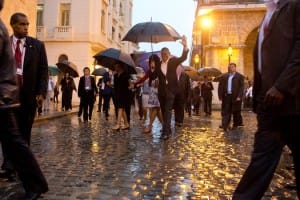
Cubans Pack the Streets for a Glimpse of President Obama
 The president and Michelle Obama in Old Havana on Sunday. Credit Stephen Crowley/The New York Times
The president and Michelle Obama in Old Havana on Sunday. Credit Stephen Crowley/The New York Times
HAVANA — Shouts of “U.S.A.!” and “Obama!” echoed over the stone plazas as President Obama and his family made their way around rain-slicked courtyards in Old Havana on Sunday evening, savoring the adulation of Cubans welcoming him warmly despite a driving rain as he began a history-making visit.
“Welcome to Cuba! We like you!” a man shouted as Mr. Obama’s entourage passed. Above, a woman applauded and hooted from her wrought-iron balcony.
Later, a motorcade including the presidential limousine, adorned for the first time with Cuban and American flags, snaked through narrow streets where elated residents, their clothing soaked from waiting in the rain, hoisted cellphones and cheered the first sitting American leader to set foot on Cuban soil in 88 years.
Mr. Obama himself marveled aloud at the significance of his trip.
“It’s a historic opportunity to engage directly with the Cuban people and to forge new agreements and commercial deals,” he told employees of the United States Embassy, his first stop in the country, “and build new ties between our two peoples, and for me to lay out my vision for a future that’s brighter than our past.”
Noting that Calvin Coolidge, the last sitting president to visit the island nation, in 1928, had arrived on a battleship after a three-day journey, Mr. Obama remarked, “It only took me three hours.”
Mr. Obama thanked embassy personnel who had brought young children to the ceremony. “By the time they’re adults,” he said, “our hope is that they think it’s natural that a U.S. president should be visiting Cuba, and they think it’s natural that the two peoples are working together.”
The Obamas then set off for the cobblestone streets of Old Havana, strolling to a statue of Carlos Manuel de Céspedes and then to the Museum of the City of Havana, set in a leafy courtyard that features a statue of Christopher Columbus.
At the Cathedral de San Cristóbal de la Habana, Mr. Obama met with Cardinal Jaime Ortega, who played a pivotal role in the secret talks that led to an initial rapprochement in 2014. The cardinal made a clandestine trip to the White House as an interlocutor for Pope Francis to prod an agreement between Mr. Obama and President Raúl Castro.
The sightseeing was a prelude to a meeting Mr. Obama is to have on Monday with his Cuban counterpart — the first official meeting of the two governments in more than a half-century.
All around the city on Sunday, Mr. Obama’s name could be heard — before he arrived, when bartenders on a hotel rooftop thought they saw his entourage; when he landed, as groups of Cubans stood under verandas by the sea; and in homes across the city, where families watched him wave and smile on Cuban television.
“It totally satisfies my soul to be able to have lived to see this moment, a moment I never thought I would have seen,” said Carmen Diaz, 70, watching Mr. Obama’s arrival from her daughter’s living room. “I feel this visit of an American president to Cuba is being done in the most elegant way possible.”
Still, between the rain and the muscular security presence throughout Havana after the arrest of dozens of dissidents Sunday morning, the arrival brought out little of the excitement and pride that many Cubans have expressed at having an American president — and better yet, this president — in their midst.
In Old Havana, many of the old streets were empty during Mr. Obama’s tour. A few people tried to sneak a peek at the president, but were turned back more than a dozen blocks away. One shop owner, near a poster showing President Castro and President Obama together, said before Mr. Obama landed that she had been told to close her shop during his walk through the area.
“People will look in the windows,” she said. “It’s fine. I’ve been talking to all my friends about Obama, and we’re all just happy to see him coming.”
Mr. Obama has long been admired by Cubans, first as a candidate, then as a president. When he announced restored relations with Cuba on Dec. 17, 2014, he came to embody a Cuban moment that symbolizes opportunity. That date is now recited often as a new national starting point, joining other historic dates, like July 26, 1953, when President Castro’s brother Fidel mounted an attack on the Moncada barracks, initiating the revolution.
The Cuban government has signaled that its leaders and people plan to treat the president with respect. They have been working to beautify Havana for weeks.
Roads with more potholes than flat patches have been repaved. Buildings along the president’s route have also been painted in attractive pastels, prompting Cubans to call the president “Saint Obama” and to joke, “Too bad Obama can’t stay for a month or a year.”
The government, though, has also made clear to all Cubans, with editorials and preventive detentions and by other means, that it will not tolerate public demonstrations or any other form of public dissent — against the government or the United States. That urge for control has left some Cubans with nagging doubts about what this trip, and the change in United States-Cuba relations, really means.
Outside the baseball stadium that Mr. Obama will visit on Tuesday, Juliet Garcia Gonzalez, 17, said she was glad the president was visiting because he had given her generation hope, a rare commodity in a country that has long seemed stuck in place. She just wasn’t sure it was enough.
“I want to travel, I want to leave,” she said, tapping at her phone, connected through a new Wi-Fi hot spot outside the stadium. “I want to come back when Cuba is better.”
